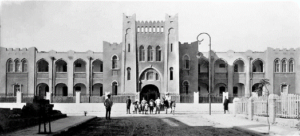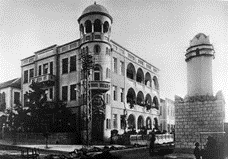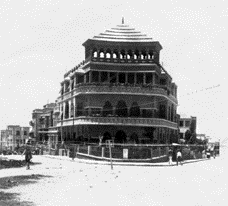By: NICOLE LEVIN
HERZL’S UTOPIAN
IDEAS THAT INSPIRED THE URBAN PLANNING OF TEL AVIV
On April 11, 1909, a large group of people stood on the sand dunes about 500 meters from the outskirts of Jaffa and drew lots. It was an historical moment: these were the 66 founding families of Ahuzat Bayit, the neighborhood that would later become the city of Tel Aviv
The name Tel Aviv comes from the Hebrew title of Herzl’s book Altneuland, translated by Nachum Sokolov. Herzl’s vision, as presented in this famous work, reflects the spirit of his times, and the essence of European progress. He was a prominent prophet of urban Zionism, and his writings reflect a keen knowledge of European urban spaces. Therefore, it is no surprise that the founders of Ahuzat Bayit, mainly immigrants from Western countries seeking to build a modern neighborhood according to European standards, were inspired by his ideas
Towards the end of the Ottoman rule, there was very little government supervision on private construction, land use, health and sanitation matters. In this atmosphere, local residents had the freedom to launch new initiatives, and thus Ahuzat Bayit, later Tel Aviv, was conceived
Though the familiar saying is that Tel Aviv “sprung up from the sands,” it was planned and built, for the most part, according to modern town planning principles, which prioritize new over old, separate dissimilar populations (for example, Jews and Arabs) and promote modern capitalist development. Its founders, committed to Zionist ideology, aspired to create a clean, beautiful, and healthy living environment, in contrast to the Arab town of Jaffa. Their model was the “garden city" envisioned by Ebenezer Howard, an English urban planner and founder of the garden city movement. They were familiar with Walhalla, the German Templar colony that resembled a garden suburb. in addition, there was Sarona, and an additional Templar colony built on the site of the failed American Colony; these were agricultural colonies that had some of the characteristics of an urban suburb. Akiva Arieh Weiss, one of Ahuzat’s Bayit’s founders, recounts in his memoires that ahead of his aliyah to Eretz Yisrael, he collected a mass of information on urban planning, and for this purpose even visited an international exhibition in Belgium on architecture and city building
The neighborhood regulations and plans
The founding committee of Ahuzat Bayit presented their model for the garden neighborhood to the administration of Keren Kayemeth Le’Israel (Jewish National Fund) in Cologne. In their letter, they describe a modern neighborhood that would be built “with order and systematic elegance;’’ feature “beautiful wide streets;” and address “sanitation issues, such as drainage, plumbing and so forth”
Many partners were involved in the process of choosing a plan for the new neighborhood, among them local representatives of the World Zionist Organization, headed by Arthur Ruppin; Keren Kayemeth Le’Israel, who helped finance the project; members of Ahuzat Bayit’s founding committee; senior Zionist technocrats; as well as architects, engineers, planners, and surveyors. Zionist experts
from Europe, who were associated with Herzl were brought in as

Gymnasia Herzliya (photo: KKL-JNF Archive)
consultants to Achuzat Bayit to provide input, for example, Jewish Austrian architect Wilhelm Stiassny and the Viennese architect Oscar Marmorek. Haifa engineer Joseph Treidel as well as Boris Schatz, founder of Bezalel School of Design, also submitted plans. The main issues addressed in these various plans was the desired width of streets, how much space to allot for parks, and where to build the first Hebrew high school, later to be named Gymnasia Herzliya
Treidel’s plan, submitted in 1908, allotted land for the gymnasium, a playground, and a public garden. In the elevated part of the terrain, he suggested building the residential units, while the eastern part would be used for gardens, parks, and a playground. This was the plan finally approved, though with many changes. The founders wanted to reduce the proposed amount of land for public parks so that there would be more lots for residential construction. In addition, they rejected Treidel’s location for a main road, and instead opted for a 12-meter- wide main road (Herzl Street) that would divide the neighborhood from north to south. The secondary streets, intersecting with the main road, were to be 10 meters wide. The plan included 79 lots
for housing and each member had to buy between 620-1120 square meters of land to ensure spacious construction. No land was allocated for a public park in the end, and the new residents made do with private gardens, boulevards lined with ornamental trees, and a park in the courtyard of the gymnasium. Contrary to the original plan, Sderot Rothschild became the public park of the neighborhood, because this was the site where sand that was removed by wheelbarrow from the building lots was dumped; as a result, houses could not be built there. Instead, it became a large boulevard with trees and flowers, paths, and benches. The final plan approved was based on a variety of planning trends: the popular orthogonal grid, some ideas from Ebenezer Howard’s model and an artistic urban trend. This latter trend stressed cultural values of aestheticism and monumentalism, and it was also reflected in the choice of location for the Herzliya Gymnasium
When it came time to formulate the building standards and regulations for the new neighborhood, Arthur Ruppin, who had been tasked with this assignment, drew from both Ebenezer Howard’s writings as well as a guide to city planning composed by Josef Stubben, a German urban planner and one of the best-known theorists in the field. Formulated in 1910, these regulations included detailed construction laws as well as a list of residents’ obligations. For example, lots were to be half a dunam to a dunam in size, and ample space (at least one meter between borders of neighboring houses) would be left to enable proper ventilation; the residents would be responsible for keeping the courtyards clean. Land would be allocated for a public park. In addition, houses would be surrounded with gardens at least 2 meters in width and demarcated by a low fence. Roads would be wide and lined with sidewalks; water and sewage pipes would be installed in all the houses
The location of the Gymnasium
The location of the first Hebrew language high school, or gymnasium, was the subject of heated discussions The minutes of these meetings reflect the extent to which a group of immigrants from Odessa (who were also active in Herzl’s Zionist movement) managed to influence many of the planning processes in the city. Some Gymnasium graduates from Odessa were among the founders of Ahuzat Bayit, including BenZion Mossinsohn, Yehuda Matman-Cohen, Menachem Sheinkin, and they worked, with the encouragement of Menachem Ussishkin (also from Odessa) to shape the cultural life of the new neighborhood with emphasis on secularism and productivity, along the lines of what they had known in Odessa. They insisted that the school, named Gymnasia Herzliya after Herzl, be built so that it would be seen by train passengers as they crossed Herzl Street, even though, practically speaking, this location blocked the main artery of the neighborhood. The school symbolized the emergence of a new urban Zionist model, which prioritized secular
culture as well as architectural aestheticism, so, despite the “problematic location,” the decision passed. This was a defining moment that shaped Tel Aviv as a new spiritual center, and enabled Ahad Ha’am, who lived in the Gymnasium complex and was part of the Odessa circle, to take on an important role in the cultural development of the city
Tel Aviv became a township under the British Mandate on June 11, 1921, which meant self-government and the
Emblem of Tel Aviv-Yafo, 1934
ability to collect taxes.1 The first city logo, designed by artist Nachum Gutman (also among the founding families of Tel Aviv), included six were merged and became one city known as Tel Aviv- Yafo today
 |
|
yellow stars, taken from Herzl’s sketch of a flag for the Jewish state; the stars symbolize Herzl’s vision of a six-day work week. (This logo was incorporated into Tel Aviv’s current logo)
The 1920s, which also included the Fourth Aliyah, brought rapid urban development. Early Zionist strategies for building Eretz Yisrael included establishing companies (such as Geula and New Society in Jaffa and later in Tel Aviv) to purchase lands that would then be sold to groups of Jews for settlement purposes or companies for the purpose of establishing a specific neighborhood (such as Ahuzat Bayit and Nachalat Binyamin)
At this time, Meir Dizengoff, head of the town council, asked Scottish town planner Patrick Geddes to draw up an urban plan for Tel Aviv. Geddes concentrated on the northern parts; he used a grid that divided the area into wide main thoroughfares which he called “mainways” and narrow residential streets which he called “homeways.” He divided the blocks into separate suburban neighborhoods within the city and set aside space for gardens between the buildings, city squares and parks. The plan, which was approved in 1926, left an indelible mark on Tel Aviv
Building styles in Tel Aviv
Up until 1921, most of the buildings were one or two-story apartment or public/commercial buildings and one-family homes. In the mid-1920s, three-story buildings began to appear, with at least six apartments in each building. The result was crowded neighborhoods. Nachalat Binyamin and Herzl Streets, and later Allenby Street, became commercial areas. Gardens in front of the houses were eliminated and the original garden suburb took on the characteristics of a city. In 1921, Aharon Zeev ben Yishai wrote that Tel Aviv was destined
to “house the beauty of Europe in the tents of Asia,” in other words, to promote the prestige of Eastern civilization by promoting European styles. This approach led to Tel Aviv’s unique and eclectic architectural landscape
The early houses of Tel Aviv can be roughly divided into two groups: a) houses that were constructed using plastered sandstone, like the houses in the Arab neighborhoods of Jaffa; and b) houses that were designed and built according to European styles and trends. One approach that influenced architecture in Eretz Yisrael, and particularly in Tel Aviv, was that of Boris Schatz, who is considered “the father of Israeli art.” Schatz sought to create a synthesis between European traditions, Jewish designs from East and West, and local culture. Consequently, Tel Aviv architecture was an eclectic mix of local Arab building styles
 |
|
 |
Top: Hotel Ginossar Bottom: The Pagoda House
combined with European and Eastern-style ornaments. Decorative elements such as cornices, railings, projections, pillars with capitals were made from cast concrete. The Herzliya Gymnasium mentioned above, designed by architect Joseph Barsky, was a good example of this kind of architecture, with its unique combination of Islamic architectural motifs such as pointed arches and horseshoe arches, serrated railings, and towers alongside Jewish elements such as the horns of the alter of the Holy Temple.
Other unique examples of this trend are Beit Ha’Pagoda (The Pagoda House) designed by architect Alexander Levi (actually an imitation
of a coffee shop building in the US); Beit HaDekel (The Palm House) designed by architect Y.Z. Tabachnik (who used biblical motifs in the décor of the building); Beit HaTeumim (The Twins House) designed by architect Joseph Berlin (with Doric pillars and arches); and the Palatin Hotel of architect Alexander Baerwald (with its arches and special overhanging balconies). The “dream houses” of Tel Aviv integrated Near-Eastern, neo-classical, art nouveau, art-deco, and Eastern European elements. Eastern and biblical elements were used to represent continuity of Hebrew history in Eretz Yisrael, and to symbolize national aspirations.
Yehuda Magidovitch, an architect from Odessa who made aliya in 1919 and became the first architect to head Tel Aviv’s building engineering department, had a major role in shaping Tel Aviv’s architectural look. His buildings featured baroque elements such as domes and twists, neo-classical pillars, gables, and eastern elements such as arches and pointed turrets. Some of his buildings were built in Provo Slavic style and some buildings were painted in various colors, such as the dome of the Ben Nahoum Hotel.
These diverse European elements reflected the bourgeois dream to build European-style cities in the Middle East. The Oriental stream that was part of Tel Aviv eclecticism was also originally imported from Europe; it was not an imitation of authentic Near-Eastern building methods, but and interpretation of Oriental design as seen through European eyes. The use of European styles in Tel Aviv represents the Zionist movement’s desire to Europeanize its cities; Tel Aviv was to be a vacation town. The colorful array of dream houses gave the city the appearance of a toy city. The proponents of this style claimed that each house represented the individual style of its owners. Critics of this phenomena, on the other hand, advocated
for a uniform building standard.
The context of the Zionist resettlement of Eretz Yisrael, these trends had national and political significance. Drawing from them, architects aspired to create a unique style that would reflect Jewish heritage and the connection to the ancient homeland. In the end, however, architects discarded these eclectic combinations and preferred to focus on European-style construction.
Where can Herzl’s vision be seen in the architecture of Tel Aviv? Not necessarily in these grand buildings, but perhaps in the buildings for workers established in the 1930’s, for example on Mazeh, Frishman, Reines streets, and Ben Gurion Boulevard. Many of these projects, which are still standing today, were planned by the Israeli architect Aryeh Sharon, a graduate of the Bauhaus School of Design in Dessau, Germany, who designed many buildings in Tel Aviv in this style.
In summary, Herzl’s influence on the history, culture and urban vibe of Tel Aviv is undeniable. Tel Aviv was the first Hebrew city which was managed entirely by Jews. For many years, on the streets of Tel Aviv, proponents of the revived Hebrew language fought for its full integration in daily life. The establishment of Tel Aviv brought with it many Hebrew cultural and educational institutions, such as theaters, opera houses and universities. Tel Aviv is the commercial center of Israel. Tel Aviv-Yafo is a mixed city, in keeping with Herzl’s concept of the Land of Israel as a place for Jews and Arabs.
In 2003, part of Tel Aviv’s historic center was declared a World Heritage Site by UNESCO, thereby increasing international tourism. Herzl would have been proud to see that Tel Aviv is the center of Israel’s booming high-tech industry; in other words, modern technology was put to good use in promoting Zionist goals. Today, due to its global economic importance, the municipality of Tel Aviv
is marketing itself as a Global City, a concept that is very much in keeping with Herzl’s utopian ideas.
Herzl died just five years before the idea of Tel Aviv was conceived, before that now-famous moment in the sand dunes in which Tel Aviv was born; nevertheless, he left his mark on this thriving urban space. It is very much his city.